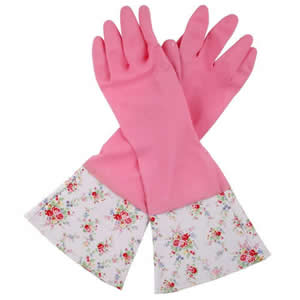I am looking at washing up gloves as part of my research because I have decided to promote my 'good' through the cunning disguise of a product which I am going to design. I have choses washing up gloves as my product because they are something that I would include in my dumpster diving pack, and I like the idea of promoting 'other uses' for them. I am aiming this product at housewives; playing on the stereotype making them a practical yet novel product, much like a lot of washing up gloves on the market at the moment, which are targeted at women by making them feminine colours, patterns and designs.
My reservations about these gloves is that in actual fact, with the exception of this first pair, I personally feel that these gloves area all really tacky and not glamorous at all. They are certainly a novelty item. Also from my research into the manufacture of these gloves, I think that it could be possible to print onto them, via pad printing.
Background information on rubber gloves....
Invented by William Stewart Halsted, household rubber gloves have been used for washing dishes and cleaning in the home since the 1960s. Many different designs of gloves have been available in a multitude of colors but traditional designs in yellow or pink with long cuffs. While these still remain the most popular patterns today, gloves can be obtained that range from wrist-length to those that are shoulder-length. There are even gloves that are pre-attached to shirts and bodysuits for added protection.
Rubber gloves are best worn with a skin tight fit which, while still allowing for the hands to breathe, makes it easier to hold objects and manipulate them. The palms and fingers usually have a raised pattern which helps provide a good grip when handling objects. Wearing gloves protects the hands from harsh detergents and other cleaning products which are used in the home and elsewhere. They also protect the wearer from bacteria involved in such tasks as the cleaning of toilets and cleaning up after pets.
These gloves are traditionally used by people cleaning in the home but are also popular with professional cleaners and for clearing up in shops, cafes and other public places. The thickness of the gloves and the long cuffs provide excellent protection for all general cleaning tasks and are useful for all chores where the hands need to be put into water, but also provide protection when vacuuming, dusting, and polishing.
The most common material used for making household gloves is latex, a form of rubber. Usually, the gloves have a cotton "flock" lining for easily taking them on and off. However, unlined gloves feel better on the skin and provide a greater ability to manipulate things. They are also available in a wider range of colors and cuff lengths. Problems with latex rubber include allergic reactions and poor protection against such substances as solvents. Other materials used to alleviate this are PVC, nitrile and neoprene. Natural rubber that has been chemically treated to reduce the amount of antibody generators, such as Vytex Natural Rubber Latex, can be used to produce a glove that retains the properties of traditional rubber while exposing the user to significantly reduced amounts of latex allergens.
This video shows in detail the process in which rubber gloves are made. I have been attempting to discover how you would print onto latex gloves in terms of industrial processes.... I am struggling to get any concrete evidence so I am going to try and contact some printers and ask their opinions. I would think that in order to print a design onto a glove you would have to use PAD, or as in quite a few of the products above, make the main part of the design as a separate object and attach it later, like the cuffs. In terms of embossing, I think that it would be possible to add the design/type to the moulds, so that it is added during the manufacturing process. It would need to be in reverse however, due to the fact that the gloves re made inside out.











I see your blog regularly. Your blog is very useful for us. If you’re looking for Foamex Signs or Printed Foamex Boards – Look no further HFE Signs are rated as the UK’s No.1 by Trustpilot with over 2,500 reviews. Delivering Printed Plastic Signs Nationwide in record time. FREE Design setup. Whether it’s a small sign for your gate or a large printed board for advertising and marketing HFE have the product for you at the best possible prices....Click here
ReplyDelete